What is social selling?
What is social selling? Social selling is a methodology designed to develop relationships as part of the sales process with your customers.
Basically, it is all about potential customers getting to know you, to like you and to trust you via sales and marketing efforts on social media. The ultimate aim is to get customers to contact you when they need your products and services.
The power of social selling is strongest when you work with B2B relationship sales and long term sales cycles. This is where LinkedIn is the obvious social media choice, as it is the market’s strongest business oriented platform, however social selling can theoretically also be utilised on Facebook, Instagram and Twitter.
Social selling can also take place offline during physical client meetings, as it is basically all about developing business relationships with both existing and potential new customers.
As with many other trends, the social selling methodology started in the US, where it was a natural development from the so-called “Sales 2.0” mind-set, which is all about the challenges of getting back into the initial phase of the sales process or even influencing the customer before they have an actual need.
Table of content
- The fundamentals
- The classic sales model
- The new sales model
- Ideology behind social selling
- It’s all about being social
- Start with the strategy
- Social selling in practise
- Build your digital equity
- Social selling is also about LLHI
- Look out for the pitfalls
- The benefit of social selling
- Social selling in a nutshell
- Social selling isn’t the solution to everything
One of the basic elements of social selling is approaching potential customers in a less direct manner than you would normally when using so-called cold canvassing methods. For example, calling people without having been asked to contact them and the customer having no existing knowledge of the sales person – hence the term cold canvassing, as the initial relationship between seller and potential customer is “cold”.
Another element of social selling is the sales person being allowed to create personal branding by communicating their skills and qualifications on LinkedIn (or other social media). They can do this by creating and sharing relevant content, such as blog posts, links, videos and podcasts with their network on LinkedIn in order to promote their expertise and build their credibility.
Finally, social selling is also about “social listening”, meaning that you listen for the signals and information within your network on LinkedIn and other social media with the aim of cultivating relationships through listening, learning and assisting them, as well as potentially also picking up on sales signals from their network.
A misconception we sometimes meet is people confusing social selling with the term social marketing. However, these are two very different concepts. While social marketing targets marketing professionals who work with mass communication, social selling is more focussed on sales professionals who work with one to one based relationship selling.
Another misconception is people thinking that social selling is always synonymous with LinkedIn, however that is not the case. Social selling is a methodology and mind set, with LinkedIn being the platform used to execute the social selling methodology.
Ergo the social selling methodology can also be used on other social media platforms such as Facebook, Instagram and Twitter – providing the characteristics and idiosyncrasies of the platforms are respected.and adhered to. That being said, LinkedIn is the most widely used platform when it comes to B2B relationship selling.
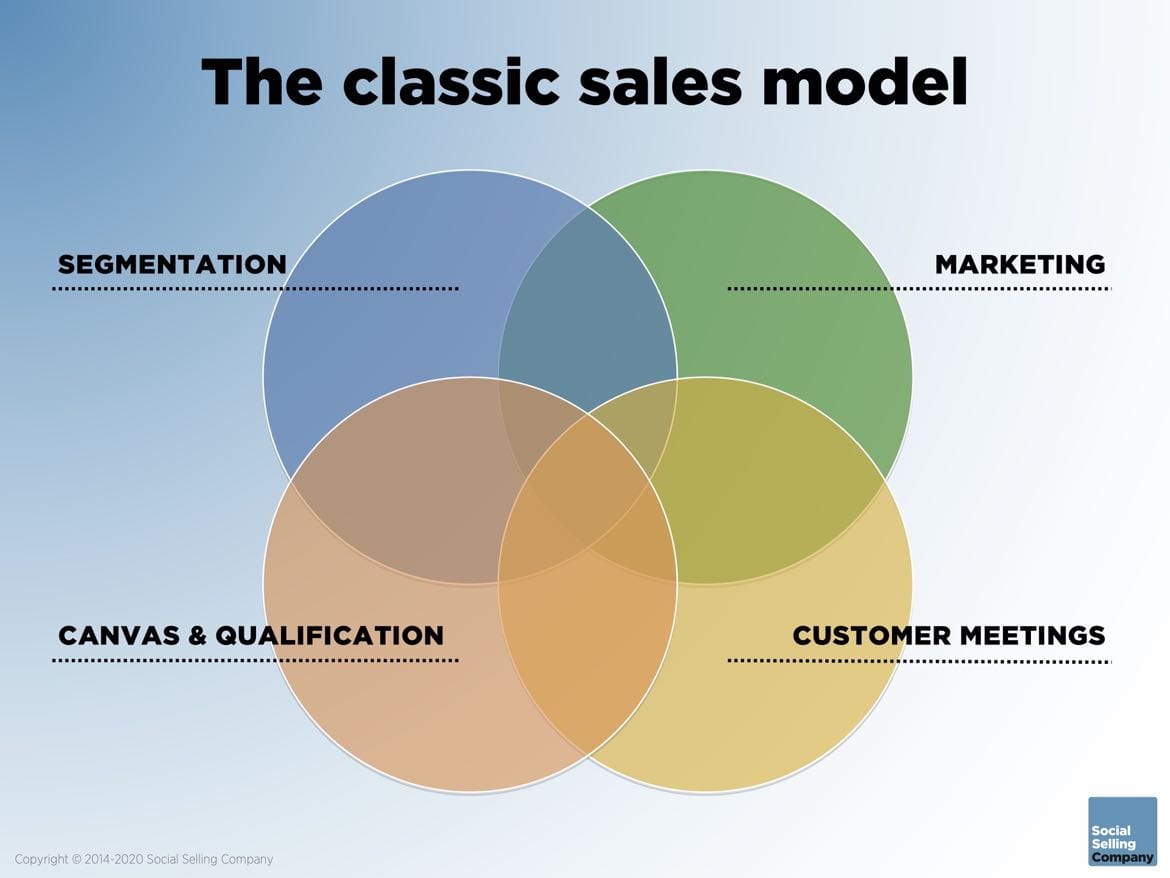
Before I elaborate further with regard to what social selling covers, we should take a look at how companies have traditionally worked with selling. This is a concept that has been used up until a few years ago, a sales model often made up of segmentation, marketing, telephone canvassing, subject qualification and client meetings.
In fact, many companies are still using the classic sales model. This has a company marketing its goods and services in printed catalogues, adverts in trade publications, newspapers or magazines as well as exhibitions and trade shows.
Customer leads are qualified by industry and whether they are a public or private company, by geography, the number of employees, potential etc. Then the sales person will call to book a meeting in order to convince them that they should do business with them.
Of course, there are various different variants of this sales model depending on the industry segment but basically, this is the way that things have been done for many years. However, the Internet and Google especially have changed the way that customers purchase goods and services. With the traditional model, it was the salesperson who drove the process but that is no longer the case. Now the customer can carry out the entire sales process online without the need to talk to a sales person on the phone or meet them face to face.
In principle, customers have never liked being sold to but they cannot avoid it these days as the sheer volume and number of sales messages has unfortunately increased. Many companies collect e-mail addresses in order to use them to communicate with potential customers and gather information regarding behaviour, preferences, tendencies, interests etc.
Last, but by no means least, companies are increasingly using this information to ”retarget” customers, as the information is used when a potential customer visits the company’s website or the company’s LinkedIn, Facebook, or Instagram pages.
You have probably experienced this when you last filled up with petrol and paid in the forecourt shop. You were probably met with a rather impersonal offer for two packets of sweets for a dollar. This is what I would call a sales person simply not thinking and being on autopilot when it comes to additional sales.
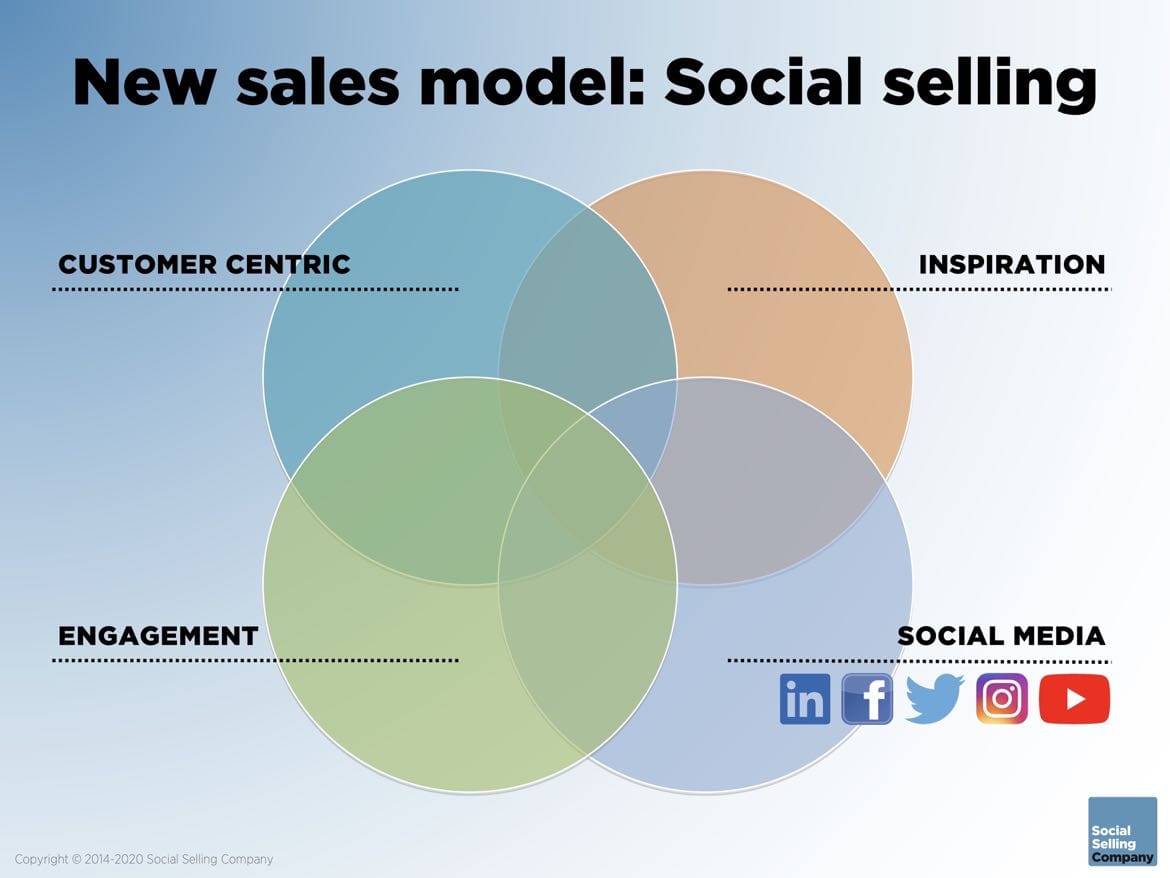
Nowadays, customers use search engines such as Google as well as social media (LinkedIn, Twitter and Facebook) to find solutions to their needs and they often ask their network for recommendations.
In fact, the modern decision maker is in a position to define their needs and inform themselves through digital information gathering. The sales person is therefore excluded from a majority of the sales process and is often only involved when it comes to discussing the price.
Studies carried out by the American research company, Forrester Research, show that the average customer can now carry out between 60 and 90 percent of the combined buying process themselves before having to contact a sales person. The modern decision maker can therefore make a lot of decisions on their own when it comes to choosing a solution and supplier.
So the roles have been reversed and now it is the customer who contacts the sales person when they are ready to continue with the buying process.
Also, the more goods that are designed to be put in an online shopping basket, the closer we are to the point where the customer can carry out the entire buying process without having to contact a sales person.
It is here that social selling and the new sales model come into play. These concepts put the customer and their challenges front and centre and provide inspiration as to how they can either resolve their challenges or find new opportunities that can help to develop or grow their business. It is also about creating commitment and actively engaging in a dialogue with customers on social media.
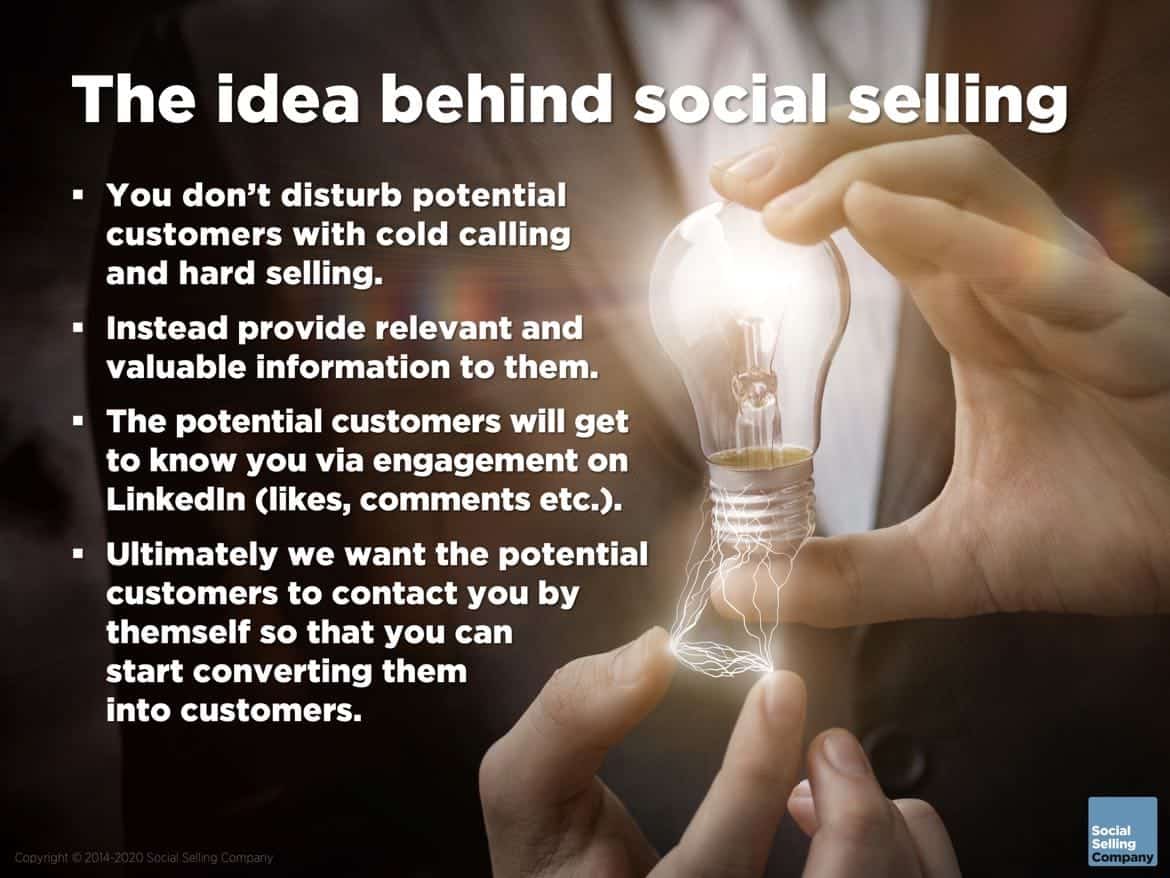
The fundamentals behind social selling are:
- You don’t bother potential customers with cold calls and “hard selling”.
- Instead, you provide them with relevant and valuable information.
- You allow them to get to know you through interaction on social media platforms such as LinkedIn.
- In the end, the customer lead will contact you and you can start working on converting them from a lead to a customer.
When you work with social selling, it is very important that you accept and take in to account the reasons why your network is on LinkedIn. As a rule, people are not on LinkedIn to be sold to.
They are actually there to:
- Be social with their network in a professional environment.
- Be kept up to date regarding their network.
- Be updated on the market and segment they are in.
- Gain knowledge.
- Find inspiration.
- Prepare for meetings.
- Keep an eye on the competition.
- Keep their CV up to date.
- Find new job opportunities.
This is why it is important that you respect the reasons why people are on LinkedIn and that you use these reasons proactively to your advantage. This means that when people use LinkedIn to seek knowledge and inspiration, you can provide it without bringing your products and direct selling in to the equation.
You can also choose to look at your network on LinkedIn as if it were a physical network group. In the real world, it is unlikely that you will be successful if you attempt direct selling the first time your network group gets together. It is far too aggressive and the wrong time as people are gathered together in order to network, learn what the other members do and help resolve any issues – exactly as you do on LinkedIn.
So social selling is actually about “unselling” and being professional socially with your network.
A classic mistake people make when implementing social selling into day-to-day sales and marketing efforts is that they post online content without there being thought and context behind it.
Unfortunately, this means that any message you want to convey gets lost in the sheer volume of posts on LinkedIn and it means that you won’t stand out from the crowd – quite the opposite.
This is why you need to define your social selling strategy and tactics before you start. If you don’t have a strategy you won’t have a clear vision to follow and even worse, you could end up going down the wrong path.– perhaps even more quickly because now you think that you have to be visible on LinkedIn and have to post as much as you possibly can.
Therefore, you need to take some time and write down your plan, including your strategic goals for your presence on LinkedIn as well as what you need to do to support your strategy and tactics.
It is a good idea to ask yourself the following questions as part of your social selling strategy process:
- Is it about increasing your visibility?
- Is there a business sector that should be given greater priority?
- Is there a need to educate the market about a certain technology, product or service?
- Do you have a “why” that can be used proactively in your social selling communication?
- Which communicative elements should you comment on on a regular basis?
- Which profiles (decision makers, influencers and users) do you want to concentrate on?
- Which social media platforms and content types will you need to use to connect with the profiles you have identified?
- What do you and your company want to be known for a year or two from now?
It is a good idea to evaluate your social selling strategy and tactics every 3-6 months to ensure that you are focussed on your strategic goals and implement concrete efforts to reach these goals.
- BE VISIBLE: You are only visible on LinkedIn if you regularly post blogs, articles, share links via your own LinkedIn profile and like and comment on other peoples posts and articles. If you aren’t visible, your target group may not notice you, your skills or your company.
- BE “LIKEABLE”: When you publish a post or write a LinkedIn article, it is important that it is relevant for and valuable to your target audience so that they want to read more from you. This means that sales messages, prices and offers are strictly forbidden, as people are not on LinkedIn to be sold to.
- BUILD TRUST: By being visible, providing inspiration and knowledge regarding your area of expertise and helping others with answers and solutions, you can begin to build trust within your LinkedIn network. It will also help with you being endorsed and recommended by others in your network.
- ESTABLISH RELATIONSHIPS: Find relevant decision makers and influencers who you want to start a dialogue with. Initially, it is all about creating a good relationship with potential customers, focussing on being helpful and getting to know the business and people, as well as understanding their role and what you can potentially help the business with.
- CREATE SALES: Once you have worked on being visible, posted content that your network feels is relevant and interesting, built trust in you as a professional and established a relationship with potential new customers, you can begin to work with specific sales efforts – setting up meetings etc.
Basically, it is all about being able to inspire customers so that they specifically choose your products and services. You can do this by helping them to resolve any challenges or issues they have via online content such as:
- Posts.
- Pictures.
- Info graphics.
- LinkedIn articles.
- Blog posts from a company website.
- Videos.
- Podcasts.
- Do-it-yourself guides.
- Reports and analysis.
- White papers.
In order to capture a customer’s interest in the best way possible, it is important that your social selling efforts are customer-centric. You can do this by understanding a customer’s actual issues – by understanding their situation and challenges, you can create a connection between them and your products and services, without having to talk directly about your products on LinkedIn.
Remember that your customers are far more interested in their own problems than in your products. So talk about their problems and have an objective discussion about how their problems can be resolved. In this way, you can exhibit real value to the customer.
When you work with social selling on a daily basis, it will typically be divided into two different forms:
- “Under the radar”: You can use the messaging function on LinkedIn for a one-on-one dialogue with individual customers or potential customers. You communicate in a confidential environment, unseen by others.
- “On the radar”: You post status updates and articles that are shown on your customers’ news stream and they can then follow your status.
This is also true when you use the “Like” button actively and when you comment on relevant updates on your news stream. This is how you can show your interest and that you have genuine expertise in your segment, as well as signalling that you are able to help your customers and network.
Social selling is also largely about personal branding as it highlights you and your expertise, so you have to be very conscious regarding your digital reputation and something I like to call your digital equity.
Your company and you as a person will be Googled by existing and prospective customers so you need to be visible on social media.
Therefore, you also have to think about your personal branding when it comes to social selling. You need to work on your personal brand and trademark and be aware of how you appear to your network.
You need to incorporate personal branding into your day-to-day social selling activities on LinkedIn and all of the other social media platforms you are active on.
When you work with social selling as part of your sales activities, you have to refrain from talking about pricing and sales campaigns. It is strictly forbidden! It basically creates “noise” within your personal LinkedIn network and will only serve to build bad will. You should really be working with “unselling”.
It is better to commit to the network mentality and focus on the social aspects and confidence building that go into creating business relationships on LinkedIn.
I have developed a model that illustrates how I think you should work with social selling on LinkedIn (primarily), but it can also be used on the many other social media platforms such as Facebook, Instagram and Twitter.
The model is called LLHI – Listen, Learn, Help, Inspire – meaning:
- Listen: Actively listen and be interested in what is happening in your network. Show your commitment by liking, sharing and writing relevant comments.
- Learn: Learn from the interesting and skilled people in your network – partly to gain knowledge and partly to learn what your network can help you with so that you know within which sectors and areas of expertise you can recommend others.
- Help: Help your network when someone is looking for something such as a recommendation for an expert within a specific area, a location for an event or sparring regarding a problem or business opportunity.
- Inspire: Inspire your network by sharing valuable knowledge. You can do this via relevant posts such as links to external articles, videos, podcasts, info graphics etc. You can also write LinkedIn articles where you share your expertise and provide your perspective on current business related challenges.

Is everything about social selling perfect and the surest way to achieving your budget every month? Absolutely not! Actually, there are some concrete pitfalls that you risk falling into when you begin working with the social selling methodology.
Realistically, it would be difficult not to fall into a trap or two now and again however if you are aware of the possible pitfalls you can do your best to avoid them
Typical social selling pitfalls are:
- Lack of a strategy: Without a strategy, there is no clear direction.
- Lack of training required to understand and execute the social selling methodology.
- No execution. A lack of execution means a lack of progress.
- Impatience regarding results: Social selling is a long term sales methodology.
- Lack of resources required to drive the social selling process.
- If you start to sell through your social selling efforts, your network will choose to ignore you as people are not on LinkedIn for direct selling.
- If views are the most important KPI: Views are fine but comments are what create a dialogue and can help to develop valuable relationships.
- Fear: If the fear of publishing becomes so great that it is better to refrain.
- Perfectionism: When you never post content online because it isn’t good enough. In this case, it is good to remember the expression “Done is better than perfect!”.
- Daily routines: If your other daily obligations overshadow and overtake your social selling efforts.

If you avoid the pitfalls and have a clear idea of what your strategy, tactics and execution should look like, incorporating social selling into your sales and marketing efforts will bring its rewards. The most important thing to point out, however, is that the rewards won’t come overnight as social selling is a long term sales strategy.
Once you have worked with social selling over a period of time the typical rewards will be:
- Increased visibility in the market – both for you as a person and for your company.
- You can highlight your expertise and professionalism.
- You can build trust within your network and your network’s network – also with potential customers you have never had contact with.
- You can create ambassadors in your network, who will proactively recommend and endorse you
- You can return to the initial part of the customer’s buying process, where decision makers collect information and ask their network for recommendations regarding products, services and companies
- You become “top of mind” in your network and your network’s network.
- You can attract new connections by sharing knowledge and inspiring others.
- You can improve your company’s image in the marketplace.
There is a lot more to say about social selling, so I have recorded a podcast episode about it together with my colleague, Eva, in order to expand on the subject. You can find the podcast episode via this link (danish language).
However, if I had to condense the social selling methodology into a concise form then it can best be described thus:
- It is all about you being visible on the same social media platforms as your customers.
- You have to be visible via content that showcases your expertise, for example posts, articles, sharing links and leaving comments.
- You need to build trust and digital equity proactively within your network by sharing relevant and valuable knowledge and by debating via comments, where you can help and share your opinions.
- You need to continually build your professional network and make an effort to cultivate and develop these relationships.
- You need to be “likeable” in your social selling efforts so that you make your network want to follow you, gain knowledge and inspiration from you and to recommend you to their network.
Once you have worked with the social selling methodology over a period of time you can begin to target your efforts in order to build on the trust you have already built up within your network and begin to capitalise on that trust in a business environment.

So is social selling the only way forward when it comes to selling in the future? Simply put, no it isn’t. It should really be used in conjunction with the existing elements in the current (classic) sales model that still work.
In the future, there is no doubt that the classic sales approach and social selling will merge into a modern sales methodology.
Until that happens, we need to exploit the new avenues that social selling presents while still talking with customers and meeting face to face.
Especially as one thing will never change. People like to deal with people.
Best regards,


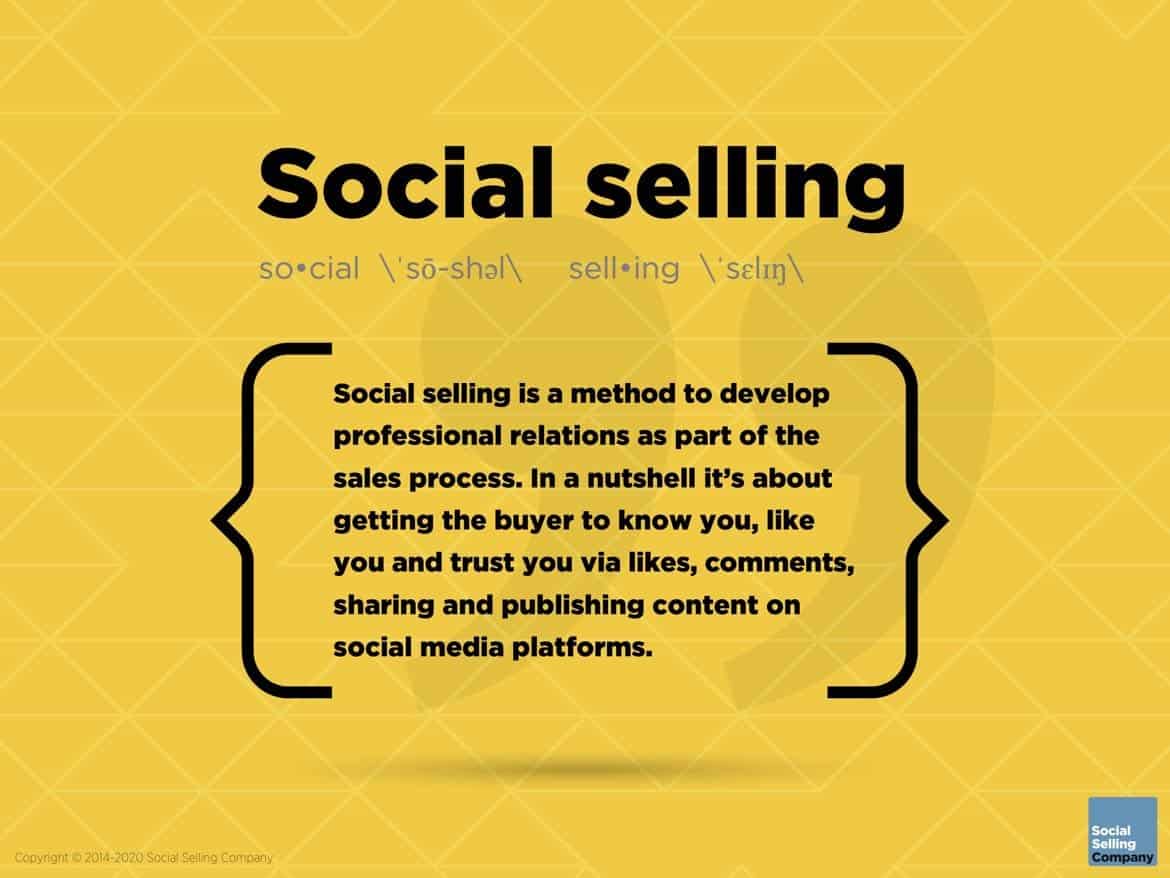
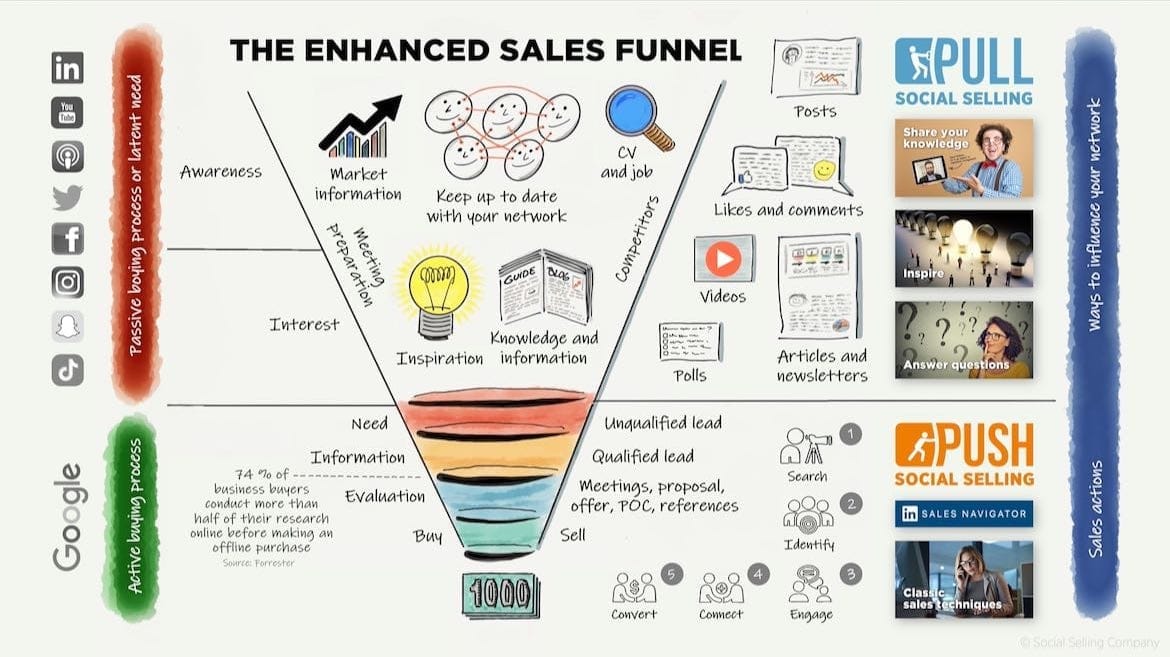
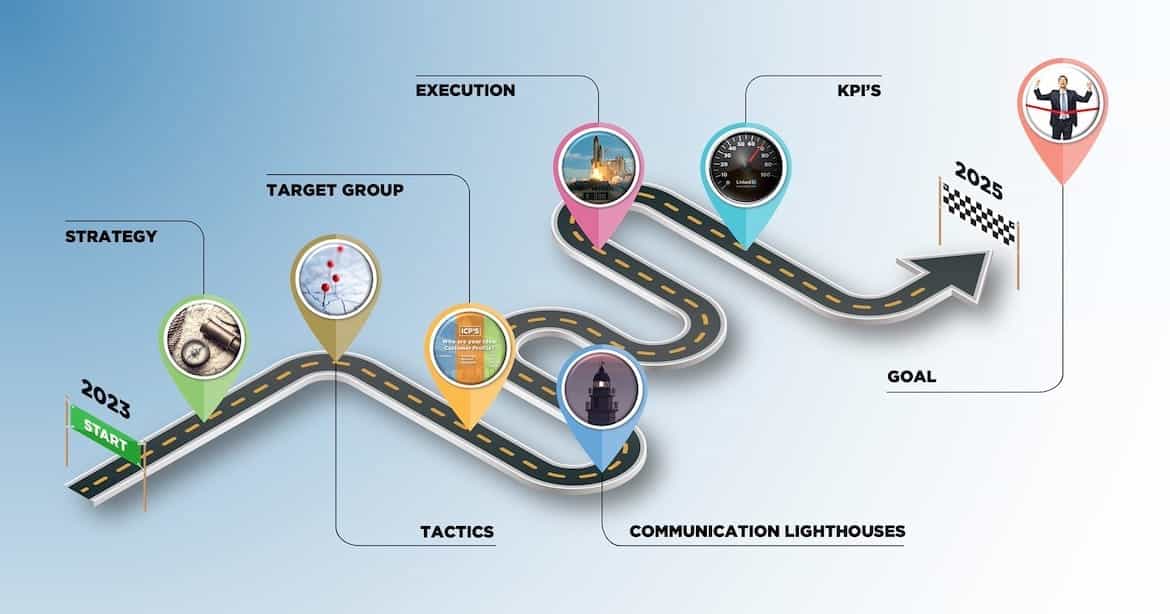
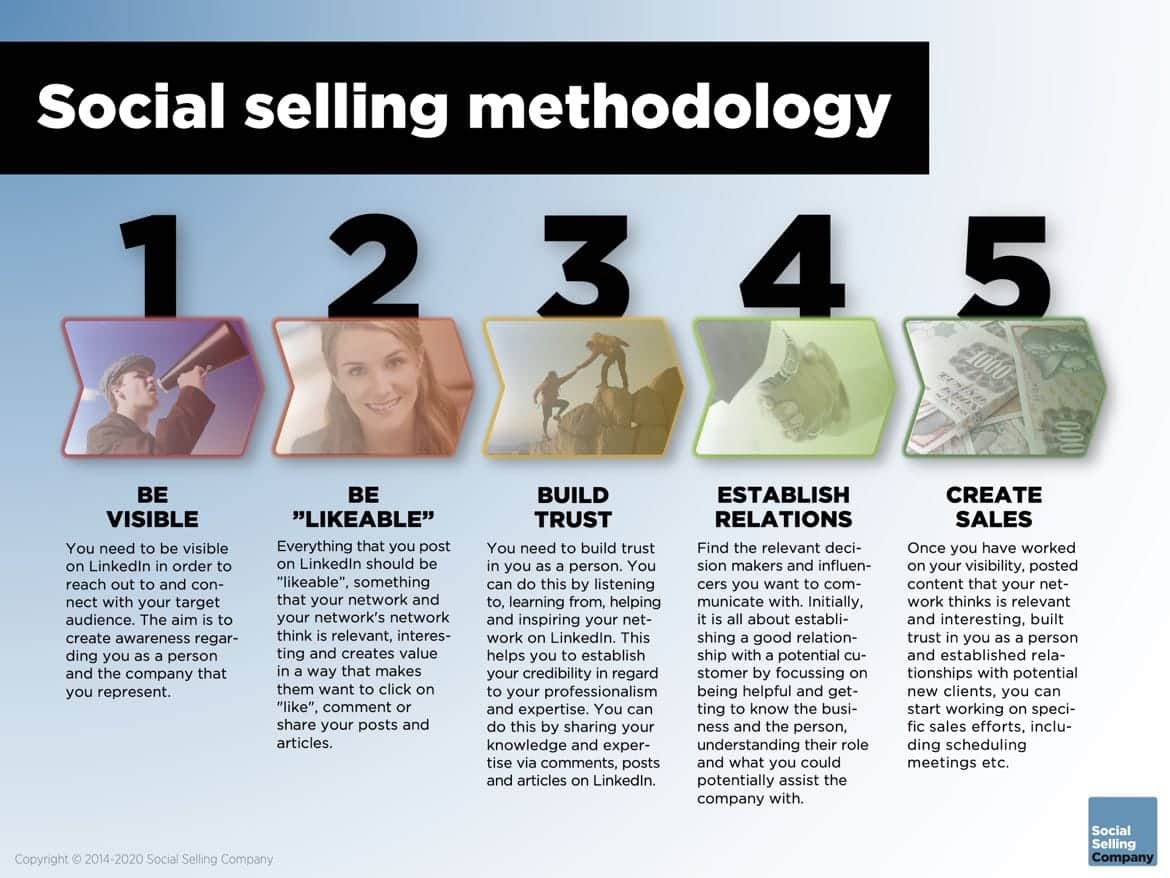
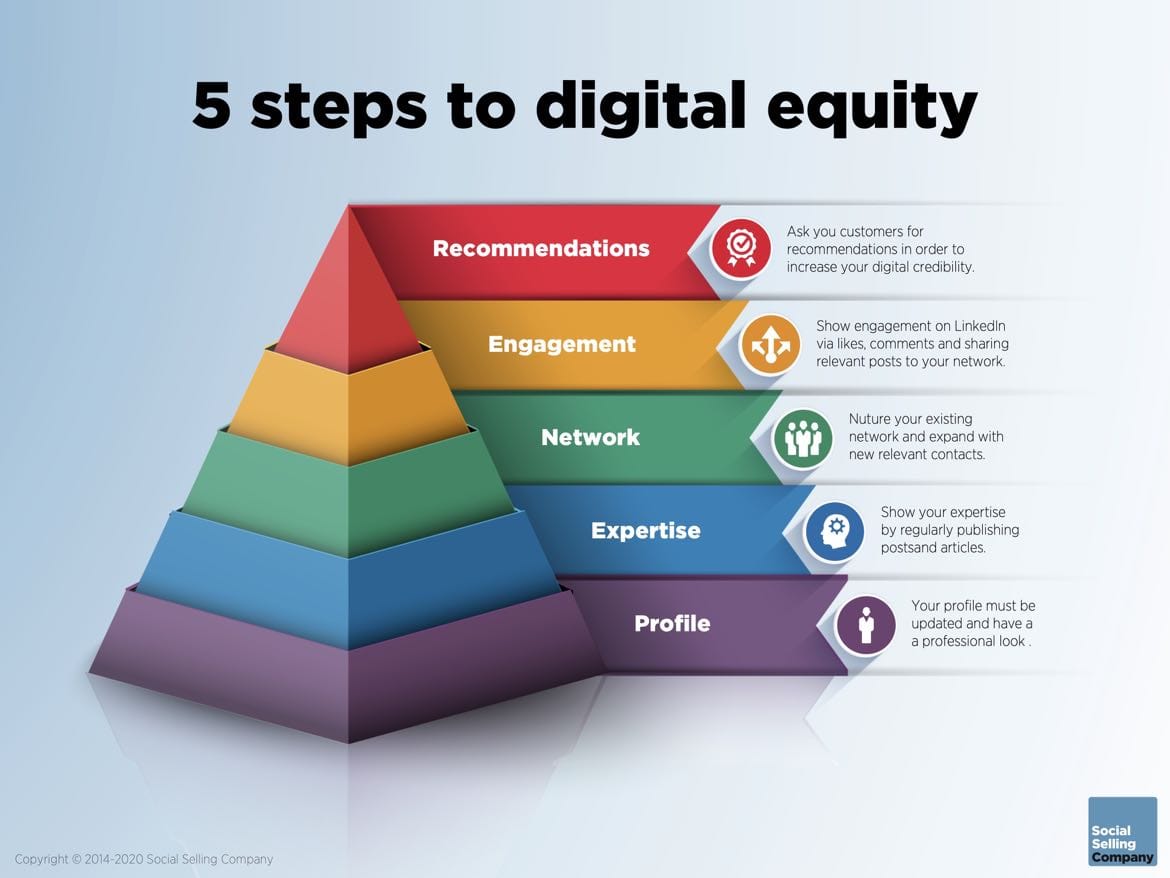
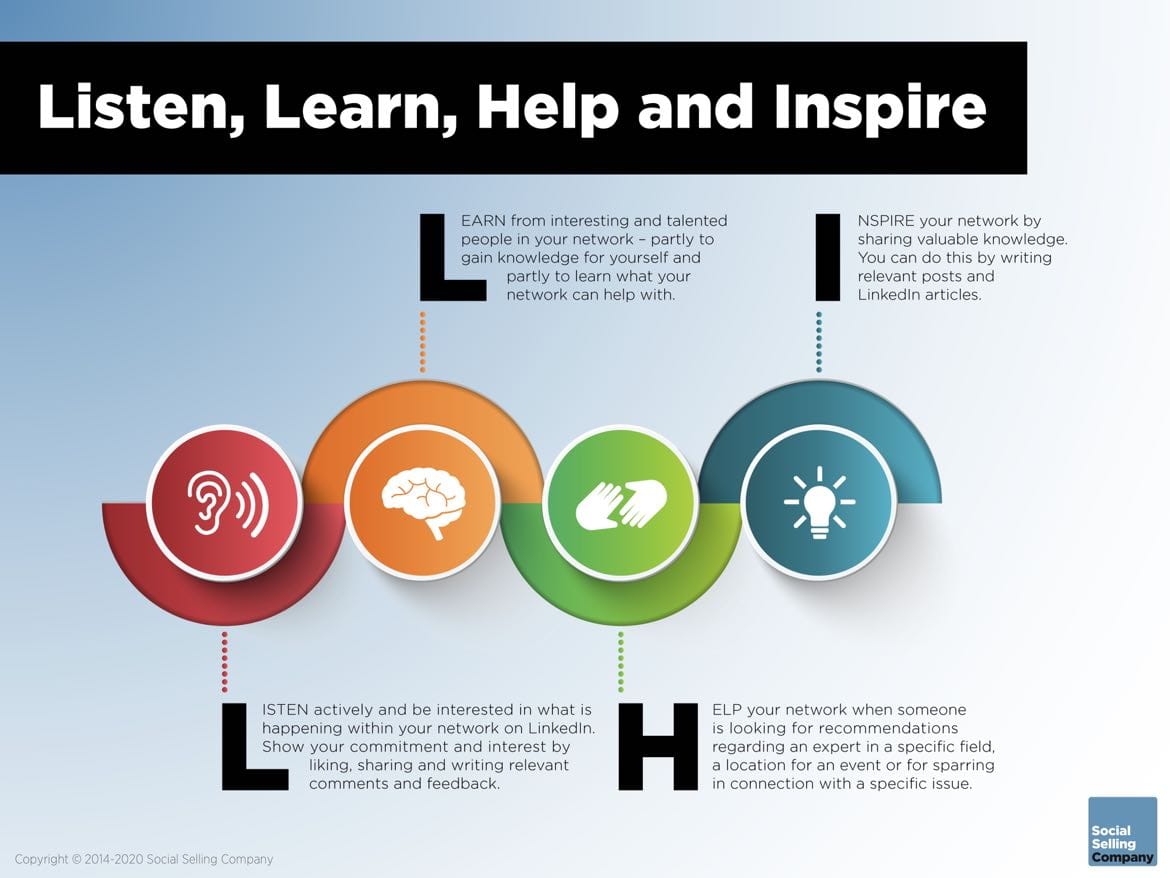

Skriv et svar